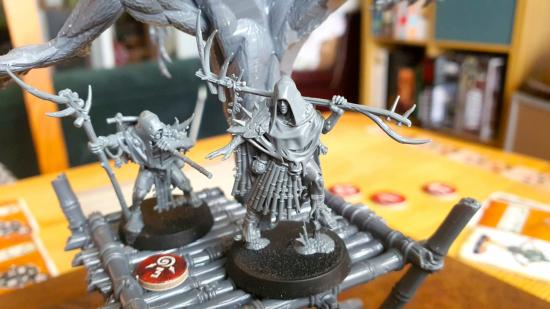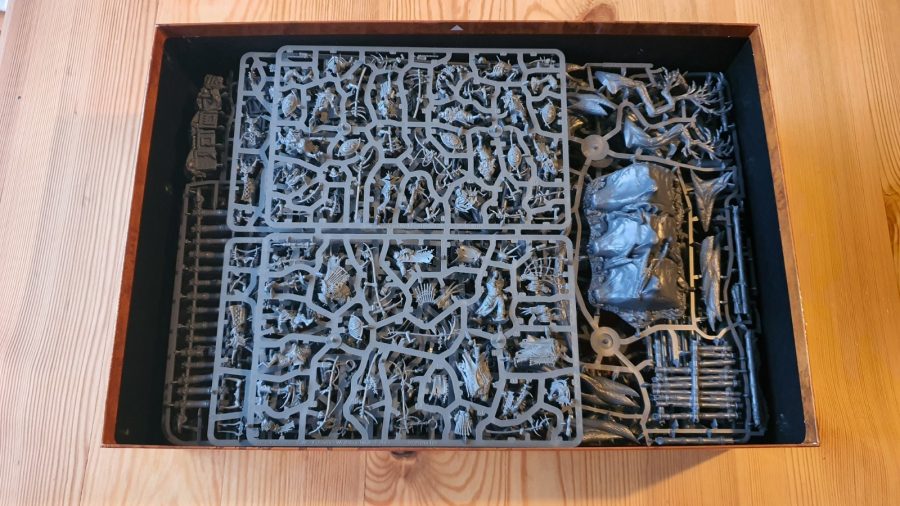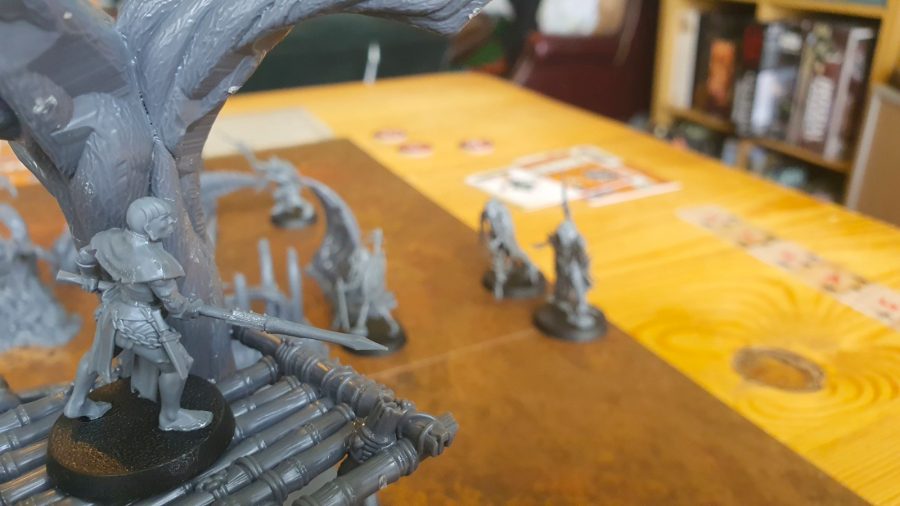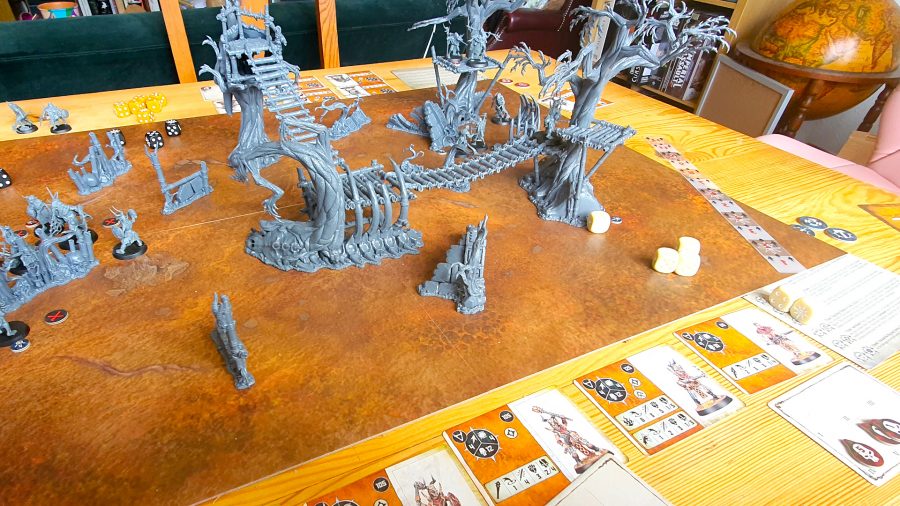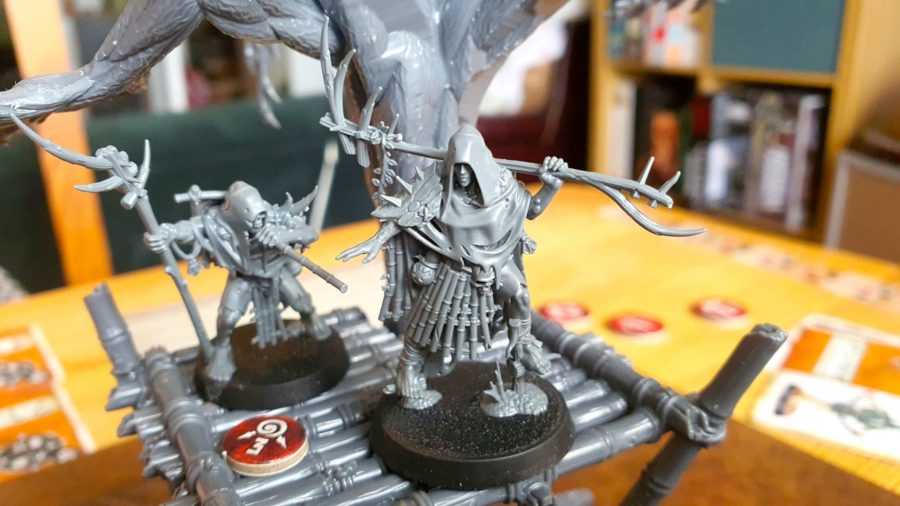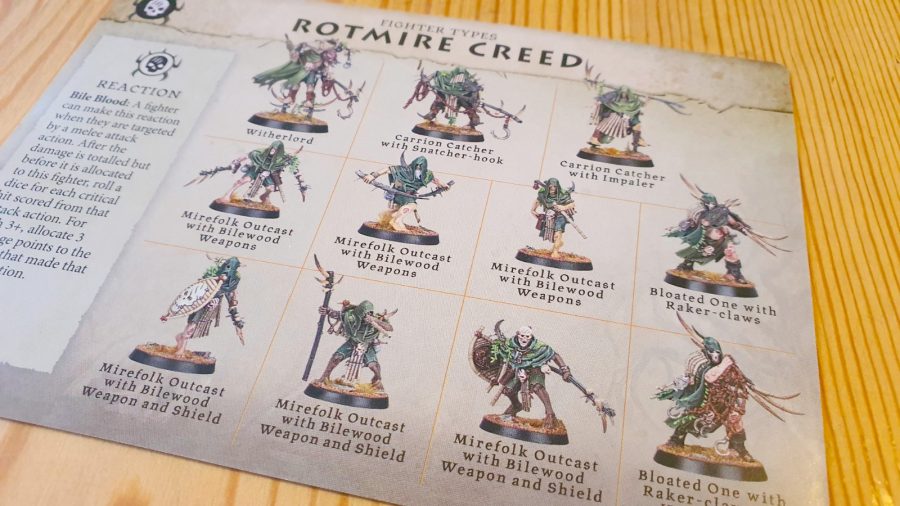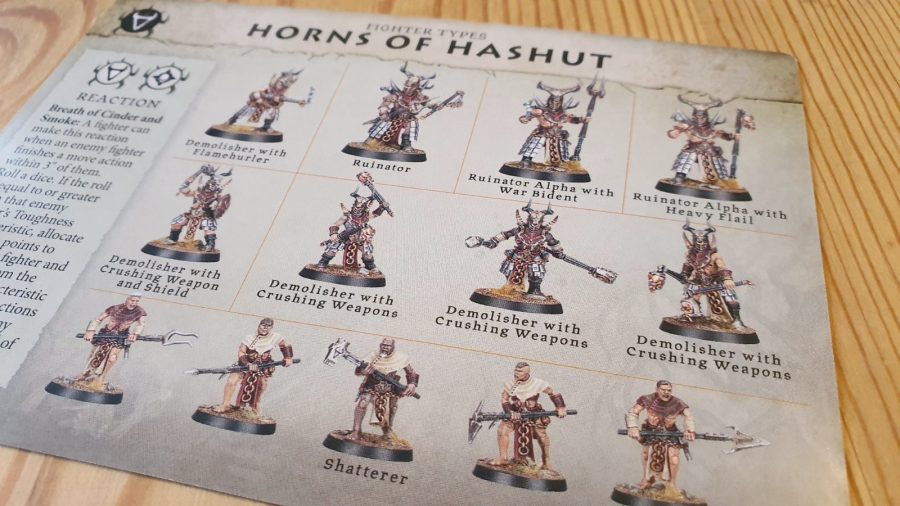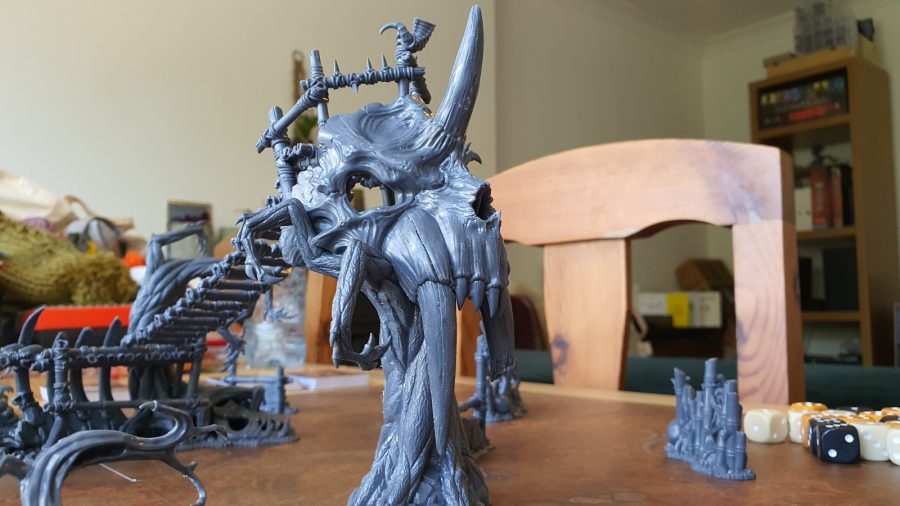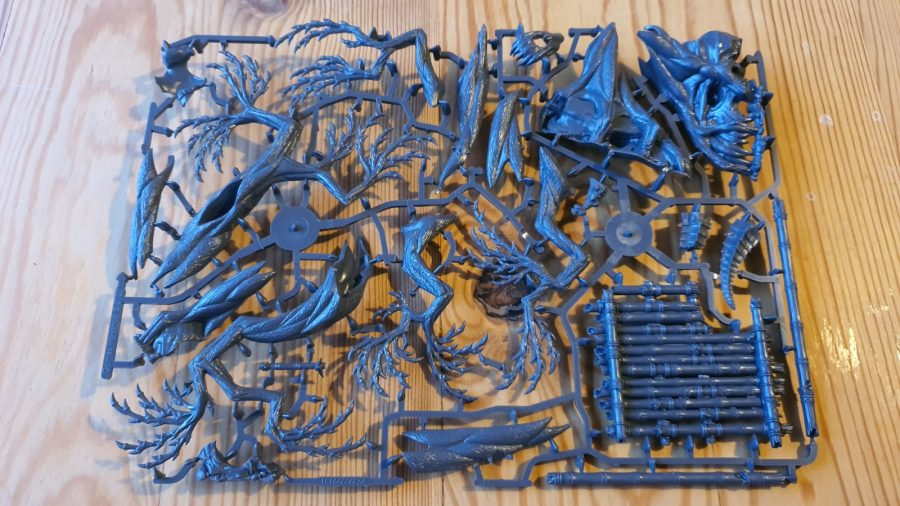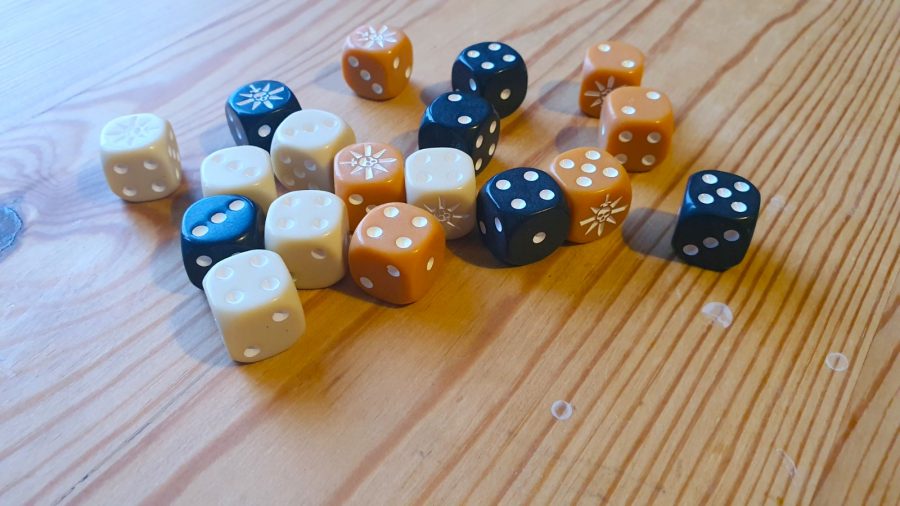Our Verdict
Like most new Warhammer these days, Warcry: Heart of Ghur's minis and terrain are masterpieces in plastic - and the excellent Warcry ruleset plays better than ever. But tricky construction and a price hike over its predecessors make this box set sub-par for Age of Sigmar beginners - the exact folks Warcry is best for.
A month after The Horus Heresy: Age of Darkness rumbled its ruddy great 31st-millennium tank tracks straight through our gaming lives, Games Workshop is now about to drop its next big box set – this time a shiny new starter set for Warcry, the smaller-scale skirmish version of its flagship fantasy wargame Warhammer Age of Sigmar.
Titled Warcry: Heart of Ghur, this box contains the plastic sprues to build two opposing warbands (a total of 20 models) and a selection of 18 jungle-flavoured terrain pieces, plus all the necessary accoutrements to play the game from a standing start. It’s a colourful, characterful set that pulled us right back into the swing of Warcry’s brutal pit-fighting.
There are questions, however. GW is fanfaring Heart of Ghur as the launch box for a “new edition” of Warcry but, despite a splendid new forest colour scheme, the actual rules haven’t evolved all that much from 2019 to 2022. At $235 / £140 (assuming the UK/US price ratio matches other recent releases), the price is also a long way north of the 2019 starter box’s accessible $170 / £100 – raising the issue of who this set is actually for.
Our Heart of Ghur review will touch on it all (many thanks to GW for sending us a free review copy) – so do come along. Watch your step, though – the trees bite.
What is Warcry: Heart of Ghur?
Warcry: Heart of Ghur – which went up for pre-order on Saturday for $235 / £140 – is the latest of four Warcry starter boxes released over the past few years – and nominally the herald of a new (i.e. second) edition for the game.
If you’ve not dipped into Age of Sigmar: Warcry since it came onto the scene in 2019, its premise was always simple: it’s AoS, but smaller, simpler, and quicker to play. Instead of a table full of a hundred minis and two hours of spellcasting and strategic wrangling, it’s only a couple of dozen models having a gory punch-up over the course of 45 minutes, tops.
Mortal forces: Our guide to all the Age of Sigmar armies
In the main play mode, you draw cards from custom packs to randomly generate all the particulars of each match – from where to put the terrain pieces, to where your groups of minis must deploy, to what the actual win conditions are.
This cuts out boring preambles, ensures each game plays a bit differently, and keeps both players’ focus on the bloody, turn-to-turn combat, rather than the high-minded list-engineering and precision positioning of GW’s full scale wargames. It’s brilliant, and a splendid Warhammer entry point for newcomers.
That format still works like a charm, and Heart of Ghur undoubtedly has everything you need to get it rolling. More specifically, in the box, you get:
- Rotmire Creed warband (ten models)
- Horns of Hashut warband (ten models)
- Warband rules cards for both warbands and each Fighter
- 18 terrain pieces (details below)
- Warcry core rulebook (160 pages)
- Heart of Ghur’s ‘Rot and Ruin’ campaign booklet (65 pages)
- Four packs of cards to generate battle maps and victory conditions
- A double sided (orangey versus browny) 30×22 inch cardboard game board
- 18 six-sided dice in green and brown jungle colours
- An A4 sheet of glossy cardboard tokens
- A floppy plastic measuring ruler
Besides the warbands and terrain – we’ll get to those in a moment – the materials are all excellent, with sturdy tokens; heavy, matt cards; and pleasantly pastel-toned dice in the jungle colour theme.
Gleaming armour: Our guide to the Stormcast Eternals
The rulebooks are as pleasing to the eye as most modern GW publications – but refreshingly shorn of the long-winded legalese that suffuses most Warhammer 40k and Age of Sigmar rules for the benefit of the tournament scene. And, speaking of Warcry’s rules…
WARCRY: HEART OF GHUR rules – reactions
So far as we can make out, Heart of Ghur neither removes, nor makes big changes to any part of Warcry’s (very good) core rule set – and makes only one significant addition: Reactions.
You’ll still play through several rounds of combat, in which you and your opponent take turns activating one of your models, and doing two actions with it (move, fight, and so on). You’ll still roll six dice at the beginning of each round, making a note of multiples of any dice result, to spend those combos on special abilities that round. You can still climb up vertical terrain for bonuses, and you can still jump (or fall) off them for lolz.
Perfidious ratmen: Read our guide to Age of Sigmar Skaven
Where Reactions change things up is by allowing Fighters (models) to take certain actions in your opponent’s turn (this was previewed by GW’s Warhammer Community site, but there’s a little more to it).

There are three universal Reactions usable by all Fighters:
- Counter – used when your model is targeted for a melee attack; the attacking model then takes one damage on failed rolls, or two on rolls of one.
- Take Cover – used when your model is targeted for a ranged attack; roll a dice for each critical hit you take, and downgrade it to a hit on each 4+
- Strike Them Down – used when an enemy in melee with your Fighter takes a Disengage action to leave combat – on a 4+, you deal them D6 damage.
These are well-considered, good fun, help keep the game’s momentum up, and – crucially – add a touch more tactical depth to the decisions you have to make (above and beyond ‘my guy’s number is bigger than that guy’s number, so I should get stuck in’).
Then, for extra narrative spice, each warband gets its own unique, narratively themed Reaction to use – sometimes usable by all its Fighters, sometimes only a select few elites.
The fiery Horns of Hashut, for example, can use Breath of Cinder and Smoke to auto-spit damaging flames at enemy Fighters that move into close range – while the Rotmire Creed’s Bile Blood gives them a two-thirds chance to deal damage back to their attacker for each critical hit they take in melee.
Reactions are a pretty simple, unobtrusive addition to Warcry’s gameplay, but they’re a neat, straightforward way to give players a few extra tactical options, and give each warband an extra ‘signature’ mechanic to play with. We like them.
WARCRY: HEART OF GHUR campaigns
In direct parallel to the Spec Ops narrative campaign rules in the current edition of Kill Team (see our Kill Team Octarius review for details), the core rulebook included in Heart of Ghur introduces an expanded Warcry campaign mode.
Now, the original Warcry core book offered each playable faction two pages of barebones campaign ‘quest’ battleplans, plus three command traits, and three ‘Artefacts’ to win for your warband. Essentially, you played a series of regular games to earn an in-game item, to use in… more regular games.
Pale killers: Read our Age of Sigmar Soulblight Gravelords guide
As with Spec Ops, Heart of Ghur’s campaign rules now introduce a bunch of new systems to flesh out a story, such as moving your warband’s base camp between locations; gaining and spending levelling-up resources (Renown and Glory); upgrading Fighters; Fighters becoming wounded or dying permanently; recruiting replacements from your model collection, and so on.
There’s a good amount of yarn from which to spin a tale about your warband’s exploits.
The box set’s included ‘Rot and Ruin’ campaign booklet also has a branching mini-campaign of pre-set battle plans with narrative fluff to go with them, intended to play out a story between the Rotmire Creed and the Horns of Hashut, while getting you properly au fait with the gameplay.
Adding colour: Read our beginner guide to painting miniatures
This has never been a flavour of Warcry we’ve delved into, so we shan’t pass much judgment in this area. But there’s undeniably more choice, narrative development, and fluffy tables to roll on here than there used to be – so, if that’s what floats your Mortal Realms skirmishing boat, Warcry’s new core book is for you. Do remember, though: that book will be available on its own in due course.
Warcry: Heart of Ghur models
Warcry’s original 2019 starter set came with the Iron Golems – a tankier warband of well-armed, metal-armoured, martial fighters wearing ornate masks – and the Untamed Beasts – a bunch of deadly, low-tech wilderness barbarians obsessed with killing in the name of chaos.
Three years on, 2022’s Heart of Ghur comes with the Horns of Hashut – a tankier warband of well-armed, metal-armoured, martial fighters wearing ornate masks – and the Rotmire Creed – a bunch of deadly, low-tech wilderness barbarians obsessed with killing in the name of chaos.
Despite the faint sense of deja vu, however, there’s a lot to love about both sets of minis, including (jokes aside) some very cool visual personality.
Rotmire Creed
The poster boys for Heart of Ghur, the Rotmire Creed are spooky, Nurgle worshipping forest folk. Clad in rags, moss, and surprisingly effective bamboo armour, they use weapons of bone, horn, or even wood – because their deep-forest home corrodes even the finest metal arms and armour. Their bamboo-toad-helmeted leader, the Witherlord, is by far the star mini of this set – no wonder they’re in all the artwork.
Horns of Hashut
Long since shown off and keenly awaited by Age of Sigmar fans, the Horns of Hashut are perhaps the Creed’s diametric opposite. These fellas are worshippers of Hashut (god of the Chaos Dwarfs in Warhammer’s Old World) who’re all about heavy armour, pointy metal horns, and fire – lots of fire.
Warcry: Heart of Ghur terrain
As is often the case with GW’s chunky, ‘all-in’ starter boxes for skirmish games like Warcry and Kill Team, a key selling point (or otherwise) of the Heart of Ghur box set is its complement of plastic terrain models – in this case a bamboo-heavy jungle scene that’s a bit like the forest moon of Endor mixed with the opening scene of Raiders of the Lost Ark.
Here’s what you get:
- Two large gnarlwood tree terrain pieces with bamboo platforms
- One smaller gnarlwood tree terrain piece with a bamboo platform
- One gnarlwood ‘watchtower’ topped with a massive skull and bamboo platform
- Four loose bamboo rope bridge terrain pieces that hook between various other parts of the set at different angles
- Ten smaller scatter terrain pieces (including some sick Seraphon ruins)
When we first clapped eyes on pictures of this new scenery, we were in two minds about it. The battlefield coverage looked a little thin, the tree sculpts oddly spindly.
Deep stuff: Our Warhammer Underworlds: Nethermaze review
In the polystyrene flesh, though, Heart of Ghur’s disturbing thicket of clawed, living trees, linked by rickety bamboo platforms and rope bridges, is impressive indeed.
It creates an immersive play space that evokes its narrative setting far better than the rather generic fortress ruins we remember from the original 2019 starter box. Being able to use the the swappable rope bridges to link several different terrain pieces together in different combinations, at different angles, across the board, is a particular stroke of genius.
What it isn’t is a breeze to put together. In order to make Heart of Ghur’s towering, twisted Gnarlwood trees quite so lifelike and, er, gnarly, GW has had to design them to be built from a large number of interlocking, weird-shaped segments that are remarkably fiddly to line up and piece together.
Enter the role: Our Age of Sigmar Soulbound starter set review
Don’t get us wrong, building is part of the Warhammer experience we keen hobbyists pay for – but, unless you’re an old hand at following GW’s direction diagrams to line tabs and slots up just so, constructing these unnatural, bulbous trees is going to cause you some headaches. The terrain is impressive and satisfying – but it makes you pay for it in more than cash. But, you know – also in cash.
Should I buy Warcry: Heart of Ghur?
Warcry: Heart of Ghur is a fantastic spectacle – but, frankly, it’s a hard slog to get built, and it’s very expensive for what it is. Its strange, finger-claw-branched gnarlwood trees have a very trippy, high-fantasy feel that’s superb on its own terms, but may limit how widely folks will want to use them for other games – a key definer of value when most of your $235 is paying for the plastic trees.
Its two warbands, though very cool minis in their own right (especially the Rotmire Creed) feel a little shorthanded for the price point – and, just like the gnarlwoods, beginner modellers will have a hard time getting them built without a few bent, snapped, or otherwise mangled extremities.
Digital realms: The best Warhammer fantasy videogames
Like other Warcry box sets before it, it’s been positioned as an all-in-one starter box, suggesting GW wants it to be attractive to newcomers to Age of Sigmar as a whole (as the original Warcry was). But we think it’s too expensive for noobs to take a chance on, and the models are leagues away from the most beginner-friendly in GW’s oeuvre. Warcry remains a great ‘gateway game’ – but this is not a good gateway box.
Meanwhile, existing Age of Sigmar collectors with an eye on the “new edition” of Warcry will likely take one look at Heart of Ghur’s price point, and decide to wait for the warbands, rulebook, and scenery to be sold separately (as they surely will). Between one group and the other, we fear this box will simply get lost in the forest.
Warcry: Heart of Ghur is available to pre-order from the GW webstore now, and will release on Saturday, August 6.
